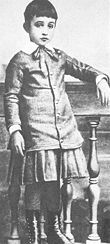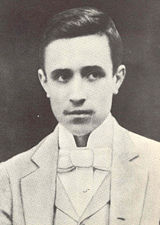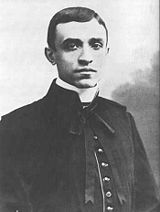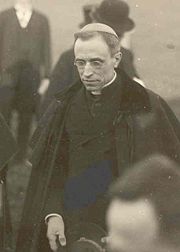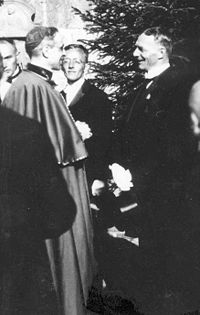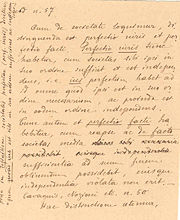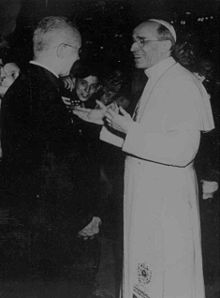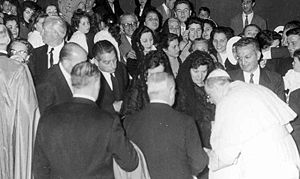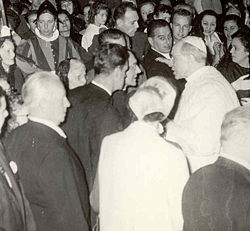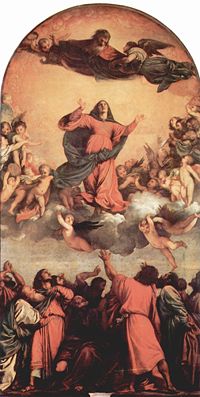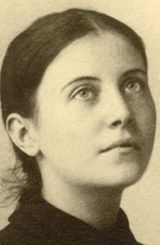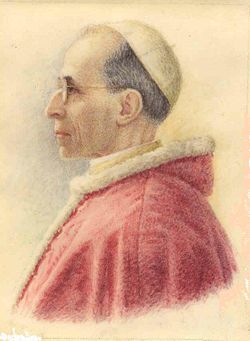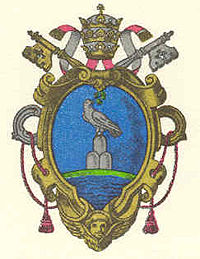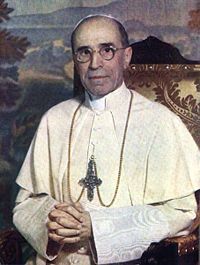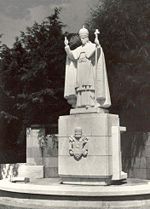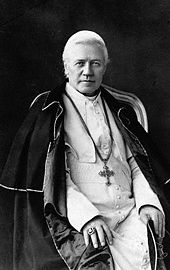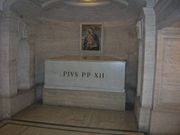Pope Pius XII
2008/9 Schools Wikipedia Selection. Related subjects: Religious figures and leaders
| Pius XII | |
|---|---|
 |
|
| Birth name | Eugenio Maria Guiseppe Giovanni Pacelli |
| Papacy began | March 2, 1939 |
| Papacy ended | October 9, 1958 |
| Predecessor | Pius XI |
| Successor | John XXIII |
| Born | March 2, 1876 Rome, Italy |
| Died | October 9, 1958 (aged 82) Castel Gandolfo, Italy |
| Other popes named Pius | |
Pope Pius XII (Latin: Pius PP. XII), born Eugenio Maria Giuseppe Giovanni Pacelli ( March 2, 1876 – October 9, 1958), reigned as the 260th pope, the human head of the Roman Catholic Church and sovereign of Vatican City, from March 2, 1939 until his death in 1958.
Before election to the papacy, Pacelli served as secretary of the Department of Extraordinary Ecclesiastical Affairs, papal nuncio and Cardinal Secretary of State, in which he worked to conclude treaties with European and Latin-American nations, most notably the Reichskonkordat with Germany. His leadership of the Catholic Church during World War II remains the subject of continued historical controversy.
After the war, Pius XII contributed to the rebuilding of Europe, and advocated peace and reconciliation, including lenient policies toward vanquished nations and the unification of Europe. The Church, flourishing in the West, experienced severe persecution and mass deportations of Catholic clergy in the East. In light of his protests, and his involvement in the Italian elections of 1948, he became known as a staunch but pragmatic opponent of Communism. He signed thirty concordats and diplomatic treaties.
Pius XII is one of only two popes (along with Pope Pius IX) to have invoked ex cathedra papal infallibility by defining the dogma of the Assumption of Mary, as proclaimed in the Apostolic constitution Munificentissimus Deus. The magisterium includes almost 1,000 addresses and radio broadcasts. His forty-one encyclicals, include Mystici Corporis, the Church as the Body of Christ; Mediator Dei on liturgy reform; Humani Generis on the Church's position on theology and evolution. He eliminated the Italian majority in the College of Cardinals with the Grand Consistory in 1946. His ongoing canonisation process progressed to the venerable stage on September 2, 2000, under Pope John Paul II.
| Styles of Pope Pius XII |
|
 |
|
| Reference style | His Holiness |
| Spoken style | Your Holiness |
| Religious style | Holy Father |
| Posthumous style | Venerable |
Early life
Pacelli was born in Rome on March 2, 1876, into a well-off aristocratic family with a history of ties to the papacy (the " Black Nobility"). His grandfather, Marcantonio Pacelli, was Under-Secretary in the Papal Ministry of Finances and then Secretary of the Interior under Pope Pius IX from 1851 to 1870 and founded the Vatican's newspaper, L'Osservatore Romano in 1861; his cousin, Ernesto Pacelli, was a key financial advisor to Pope Leo XIII; his father, Filippo Pacelli, was the dean of the Sacra Rota Romana; and his brother, Francesco Pacelli, became a lay canon lawyer, credited for his role in negotiating the Lateran Treaty in 1929, bringing an end to the Roman Question. At the age of twelve, Eugenio announced his intentions to enter the priesthood instead of becoming a lawyer.
After completing state primary schools, Pacelli received his secondary, classical education at the Visconti Institute. In 1894, at the age of eighteen, he entered the Almo Capranica Seminary to begin study for the priesthood and enrolled at the Pontifical Gregorian University and the Appolinare Institute of Lateran University. From 1895–1896, he studied philosophy at University of Rome La Sapienza. In 1899, he received degrees in theology and in utroque iure (civil and canon law). At the seminary, he received a special dispensation to live at home for health reasons.
Church career
Priest and Monsignor
He was ordained a priest on Easter Sunday, April 2, 1899 by Bishop Francesco Paolo Cassetta — the vice-regent of Rome and a family friend — and received his first assignment as a curate at Chiesa Nuova, where he had served as an altar boy. In 1901, he entered the Congregation for Extraordinary Ecclesiastical Affairs, a sub-office of the Vatican Secretariat of State, where he became a minutante, at the recommendation of Cardinal Vannutelli, another family friend.
In 1904, Pacelli became a papal chamberlain and in 1905 a domestic prelate. From 1904 until 1916, Father Pacelli assisted Cardinal Pietro Gasparri in his codification of canon law with the Department of Extraordinary Ecclesiastical Affairs. He was also chosen by Pope Leo XIII to deliver condolences on behalf of the Vatican to Edward VII of the United Kingdom after the death of Queen Victoria. In 1908, he served as a Vatican representative on the International Eucharistic Congress in London, where he met Winston Churchill. In 1911, he represented the Holy See at the coronation of King George V.
In 1908 and 1911, Pacelli turned down professorships in canon law at a Roman university and The Catholic University of America, respectively. Pacelli became the under-secretary in 1911, adjunct-secretary in 1912 (a position he received under Pope Pius X and retained under Pope Benedict XV) and secretary of the Department of Extraordinary Ecclesiastical Affairs in 1914 — succeeding Gasparri, who was promoted to Cardinal Secretary of State. As secretary, Pacelli concluded a concordat with Serbia four days before Archduke Franz Ferdinand of Austria was assassinated in Sarajevo. During World War I, Pacelli maintained the Vatican's registry of prisoners of war. In 1915, he travelled to Vienna to assist Monsignor Scapinelli — the apostolic nuncio to Vienna — in his negotiations with Franz Joseph I of Austria regarding Italy.
Archbishop and Papal Nuncio
Pope Benedict XV appointed Pacelli as papal nuncio to Bavaria on April 23, 1917, consecrating him as titular Bishop of Sardis and immediately elevating him to archbishop in the Sistine Chapel on May 13, 1917, the very day, Our Lady of Fatima is believed to have first appeared to three shepherd children in Fatima, Portugal. After his consecration, Eugenio Pacelli left for Bavaria.
- The Vatican Peace Initiative
As there was no nuncio to Prussia or Germany at the time, Pacelli was, for all practical purposes, the nuncio to all of the German Empire. Once in Munich, he conveyed the papal initiative to end the War to German authorities. He met with King Ludwig III on May 29, and later with Kaiser Wilhelm II. and Chancellor Bethmann-Hollweg, who replied positively to the Papal initiative. Pacelli saw “for the first time a real prospect for peace”. However, Bethmann-Hollweg was forced to resign and the German High Command, hoping for a military victory, delayed the German reply until September 20. Pacelli was “extraordinarily disappointed and depressed”, since the German note did not include the concessions promised earlier. For the remainder of the war, he concentrated on Benedict’s humanitarian efforts.
After the war, during the short-lived Bavarian Soviet Republic in 1919 Pacelli was one of the few foreign diplomats to remain in Munich. According to Pascalina Lehnert, who was personally there at the time, Pacelli calmly faced down a small group of Spartacist revolutionaries, who had entered the nunciature by force in order to take his car. Pacelli told them to leave the extraterritorial building, to which they responded, "only with your car". Pacelli, who had previously ordered to disconnect the starter, permitted the car to be towed away, after he was informed that the Bavarian government had promised to return the vehicle at once. Several versions of this incident and alleged later incidents are much more colorful, but, according to the relator in the beatification process in the Vatican, "mostly based on imagination" The popular view may also overlook his cordial relations with socialist politicians like Friedrich Ebert and Philipp Scheidemann, and his prolonged secret negotiations with the Soviet Union (see below). “Pacelli is simply too intelligent to be irritated by something like this” opined the Bavarian representative at the Vatican.
On the night of Adolf Hitler's Beer Hall Putsch, Franz Matt, the only member of the Bavarian cabinet not present at the Bürgerbräu Keller, was having dinner with Pacelli and Michael Cardinal von Faulhaber. The American diplomat Robert Murphy, then in Munich, writes that "all the foreign representatives at Munich, including Nuncio Pacelli, were convinced that Hitler's political career had ended ignominiously in 1924. When I ventured to remind His Holiness of this bit of history (in 1945), he laughed and said: 'I know what you mean - papal infallibility, Don't forget, I was only a monsignor then'."
- The First Nuncio in Berlin
Several years after he was appointed Nuncio to Germany, and after completion of a concordat with Bavaria, the nunciature was moved to Berlin. June 23, 1920 and 1925 respectively. Many of Pacelli's Munich staff would stay with him for the rest of his life, including his advisor Robert Leiber and Sister Pascalina Lehnert — housekeeper, friend, and adviser to Pacelli for 41 years.
In Berlin, Pacelli was doyen or Dean of the Diplomatic Corps and active in diplomatic and many social activities. There he met notables like Albert Einstein, Adolf von Harnack, Gustav Stresemann, Clemens August Graf von Galen, and Konrad Cardinal von Preysing, the later two he elevated to cardinal in 1946. He worked with the German priest Ludwig Kaas, who was known for his expertise in Church-state relations and was politically active in the Centre Party.. While in Germany, he enjoyed working as a pastor. He traveled to all regions, attended Katholikentag (national gatherings of the faithful), and delivered some 50 sermons and speeches to the German people.
- Negotiations with the Soviet Union (1925-1927)
In post-war Germany, Pacelli worked mainly on clarifying the relations between Church and State (see below). But in the absence of a papal nuncio in Moscow, Pacelli worked also on diplomatic arrangements between the Vatican and the Soviet Union. He negotiated food shipments for Russia, where the Church was persecuted. He met with Soviet representatives including Foreign Minister Georgi Chicherin, who rejected any kind of religious education, the ordination of priests and bishops, but offered agreements without the points vital to the Vatican. “An enormously sophisticated conversation between two highly intelligent men like Pacelli and Chicherin, who seemed not to dislike each other.” wrote one participant. Despite Vatican pessimism and a lack of visible progress, Pacelli continued the secret negotiations, until Pope Pius XI ordered them to be discontinued in 1927.
- Pacelli and the Weimar Republic
Pacelli supported the Weimar Coalition with Social Democrats and liberal parties. Although he had cordial relations with representatives of the Centre Party such as Marx and Kaas, he did not involve the Centre in his dealings with the German government. Pacelli supported German diplomatic activity aimed at rejection of punitive measures from victorious former enemies. He blocked French attempts for an ecclesiastical separation of the Saar region, supported the appointment of a papal administrator for Danzig and aided the reintegration of priests expelled from Poland.. Pacelli was critical of German policy regarding financial reparations, which he considered unimaginative and lacking a sense of reality. He regretted the return of William, German Crown Prince from exile as destabilizing. After repeated German acts of sabotage against the French occupation forces in the Ruhr valley in 1923, German media reported a conflict between Pacelli and the German authorities. The Vatican denounced these acts against the French in the Ruhr.
When he returned to Rome in 1929, praise was heaped by Catholics and Protestants alike on Pacelli, who by now had become more popular than any German cardinal or bishop, which he had largely excluded from his negotiations and dealings with the German government.
Cardinal Secretary of State and Camerlengo
Pacelli was made a cardinal on 16 December 1929 by Pope Pius XI, and within a few months, on 7 February 1930, Pius XI appointed him Cardinal Secretary of State. In 1935, Cardinal Pacelli was named Camerlengo of the Roman Church.
As Cardinal Secretary of State, Pacelli signed concordats with many non-Communist states, including Baden (1932), Austria (1933), Germany (1933), Yugoslavia (1935) and Portugal (1940). The Lateran treaties with Italy (1929) were concluded before Pacelli became secretary of state. Such concordats allowed the Catholic Church to organize youth groups, make ecclesiastical appointments, run schools, hospitals, and charities, or even conduct religious services. They also ensured that canon law would be recognized within some spheres (e.g. church decrees of nullity in the area of marriage).
He made many diplomatic visits throughout Europe and the Americas, including an extensive visit to the United States in 1936 where he met with Charles Coughlin and Franklin D. Roosevelt, who appointed a personal envoy — who did not require Senate confirmation — to the Holy See in December 1939, re-establishing a diplomatic tradition that had been broken since 1870 when the pope lost temporal power.
Pacelli presided as Papal Legate over the International Eucharistic Congress in Buenos Aires, Argentina on October 10–14, 1934, and in Budapest on May 25–30, 1938.
Some historians have argued that Pacelli, as Cardinal Secretary of State, dissuaded Pope Pius XI — who was nearing death at the time — from condemning Kristallnacht in November 1938, when he was informed of it by the papal nuncio in Berlin. Likewise the prepared encyclical Humani Generis Unitas ("On the Unity of Human Society"), which was ready in September 1938 but, according to the two publishers of the encyclical and other sources, not forwarded to the Vatican by the Jesuit General Wlodimir Ledochowski. It contained an open and clear condemnation of colonialism, racism and antisemitism but also strong accusations against Jews and elements of anti-Judaism. Some historians have argued that Pacelli learned about its existence only after the death of Pius XI did not promulgate it as pope. He did however use parts of it in his inaugural encyclical Summi Pontificatus, which he titled "On the Unity of Human Society."
His various positions on Church and policy issues during his tenure as Cardinal Secretary of State were made public by the Vatican in 1939. Most noteworthy among the fifty speeches is his review of church and state issues in Budapest 1938.
Reichskonkordat
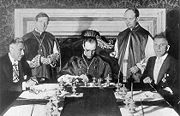
The Reichskonkordat was an integral part of four concordats Pacelli concluded on behalf of the Vatican with German States. The state concordats were necessary, because the German federalist Weimar constitution gave the states authority in the area of education and culture, which were of main concern to Vatican policy. As Bavarian Nuncio, Pacelli negotiated successfully with the Bavarian authorities in 1925. He expected the concordat with Catholic Bavaria to be the model for the rest of Germany. Prussia showed interest in negotiations only after the Bavarian concordat. However, Pacelli obtained less favorable conditions for the Church in the Prussian concordat of 1929, which excluded educational issues. A concordat with the German state of Baden was completed by Pacelli in 1932, after he had moved to Rome. There he also negotiated a concordat with Austria in 1933. A total of 16 concordats and treaties with European states had been concluded in the ten year period 1922-1932.
The Reichskonkordat, signed on July 20, 1933, between Germany and the Holy See, while thus a part of an overall Vatican policy, was controversial from its beginning. It remains the most important of Pacelli's concordats. It is debated, not because of its content, which is still valid today, but because of its timing. A national concordat with Germany was one of Pacelli's main objectives as secretary of state, because he had hoped to strengthen the legal position of the Church. Pacelli, who knew German conditions well, emphasized (1) protection for Catholic associations (§31), (2) freedom for education and Catholic schools, and, (3) freedom for publications.
As nuncio during the 1920s, he had made unsuccessful attempts to obtain German agreement for such a treaty, and between 1930 and 1933 he attempted to initiate negotiations with representatives of successive German governments, but the opposition of Protestant and Socialist parties, the instability of national governments and the care of the individual states to guard their autonomy thwarted this aim. In particular, the questions of denominational schools and pastoral work in the armed forces prevented any agreement on the national level, despite talks in the winter of 1932.
Adolf Hitler was appointed Chancellor on 30 January 1933 and sought to gain international respectability and to remove internal opposition by representatives of the Church and the Catholic Centre Party. He sent his vice chancellor Franz von Papen, a Catholic nobleman and former member of the Centre Party, to Rome to offer negotiations about a Reichskonkordat. On behalf of Cardinal Pacelli, Prelate Ludwig Kaas, the outgoing chairman of the Centre Party, negotiated first drafts of the terms with Papen. The concordat was finally signed, by Pacelli for the Vatican and von Papen for Germany, on 20 July and ratified on September 10, 1933.
Between 1933 and 1939, Pacelli issued 55 protests of violations of the Reichskonkordat. Most notably, early in 1937, Pacelli asked several German cardinals, including Michael Cardinal von Faulhaber to help him write a protest of Nazi violations of the Reichskonkordat; this was to become Pius XI's encyclical Mit Brennender Sorge. The encyclical, condemning the view that "exalts race, or the people, or the State, or a particular form of State ... above their standard value and divinizes them to an idolatrous level", was written in German instead of Latin and read in German churches on Palm Sunday 1937. On June 10, 1941 he commented on the problems of the Reichskonkordat in a letter to the Bishop of Passau, Bavaria: "The history of the Reichskonkordat shows, that the other side lacked the most basic prerequisites to accept minimal freedoms and rights of the Church, without which the Church simply cannot live and operate, formal agreements notwithstanding".
Papacy
Election and coronation
Pope Pius XI died on February 10, 1939. Several historians have interpreted the conclave to choose his successor as facing a choice between a diplomatic or a spiritual candidate, and they view Pacelli's diplomatic experience, especially with Germany, as one of the deciding factors in his election on March 2, 1939, his 63rd birthday, after only one day of deliberation and three ballots. He was the first cardinal secretary of state to be elected Pope since Clement IX in 1667. He was also one of only two men known to have served as Camerlengo immediately prior to being elected as pope (the other being Pope Leo XIII). His coronation took place March 12, 1939.
Pacelli took the same papal name as his predecessor, a title used exclusively by Italian Popes. He was quoted as saying, "I call myself Pius; my whole life was under Popes with this name, but especially as a sign of gratitude towards Pius XI." On December 15, 1937, during his last consistory, Pius XI strongly hinted to the cardinals that he expected Pacelli to be his successor, saying "He is in your midst." He had previously been quoted as saying: "When today the Pope dies, you’ll get another one tomorrow, because the Church continues. It would be a much bigger tragedy, if Cardinal Pacelli dies, because there is only one. I pray every day, God may send another one into one of our seminaries, but as of today, there is only one in this world."
After his election, Pius XII listed three objectives as pontiff.
- A new translation of the psalms, daily recited by the religious and priests, in order for the clergy to better appreciate the beauty and richness of the Old Testament. This translation was completed in 1945
- A definition of the of Dogma of the Assumption. This necessitated numerous studies into Church history and consultations with the episcopate worldwide. The dogma was proclaimed in November 1950.
- Increased archaeological excavations under St Peter's Basilica in Rome, to determine, whether St. Peter was actually buried there, or whether the Church subjected itself for more than 1500 years to a pious hoax. This was a controversial point, because of the real possibility of a major embarrassment and technical concerns, to conduct excavations under the main altar, close to the Bernini columns of the papal altar and the main support of the Michelangelo’s cupola. The first results regarding the tomb of St. Peter were published in 1950.

Appointments
After his election, he appointed Luigi Cardinal Maglione to be his successor as Secretary of State. Maglione, a seasoned Vatican diplomat, had reestablished diplomatic relations with Switzerland and was for many years nuncio in Paris, France. Yet, Maglione did not exercise the influence of his predecessor Pacelli, who as Pope continued his close relation with Monsignors Montini (later Pope Paul VI) and Domenico Tardini. After the death of Maglione in 1944, Pius left the position open and named Tardini head of its foreign section and Montini head of the internal section. Tardini and Montini continued serving there until 1953, when Pius XII decided to appoint them cardinals, an honour which both turned down. They were then later appointed to be Pro-Secretary with the privilege to wear Episcopal Insignia. Tardini continued to be a close co-worker of the Pope until the death of Pius XII, while Montini became archbishop of Milan, after the death of Alfredo Ildefonso Schuster.
Pius XII slowly eroded the Italian monopoly on the Roman Curia; he employed German and Dutch Jesuit advisors, Robert Leiber, Augustin Bea, and Sebastian Tromp. He also supported the elevation of Americans such as Francis Spellman from a minor to a major role in the Church. After World War II, Pius XII appointed more non-Italians than any Pope before him. Americans included Joseph P Hurley as regent of the nunciature in Belgrade, Gerald P. O'Hara Nuncio to Rumania and Monsignor Aloisius Joseph Muench as nuncio to Germany. For the first time, numerous young European, Asian and "Americans were trained in various congregations and secretariats within the Vatican for eventual service throughout the world."
Consistories
Only twice in his pontificate did Pius XII hold a consistory to create new cardinals, in contrast to Pius XI, who had done so seventeen times in seventeen years. Pius XII chose not to name new cardinals during World War II, and the number of cardinals shrank to 38, with Cardinal Denis Dougherty being the only living U.S. cardinal. The first occasion on February 18, 1946 — which has become known as the "Grand Consistory" — yielded the elevation of a record thirty-two new cardinals, almost 50% of the College of Cardinals and reaching the canonical limit of seventy cardinals. In the 1946 consistory Pius XII, while maintaining the maximum size of the College of Cardinals at 70, named cardinals from China, India, the Middle East and increased the number of Cardinals from the Americas, proportionally lessening the Italian influence
In his second consistory on January 12, 1953, it was expected that his closest co-workers, Monsignore Domenico Tardini and Monsignore Montini would be elevated& Pius XII informed the assembled cardinals that two persons were originally on the top of his list, but they had turned down the offer, and were rewarded instead with other promotions. The two consistories of 1946 and 1953 brought an end to over five hundred years of Italians constituting a majority of the College of Cardinals. With few exceptions, Italian prelates accepted the changes positively; there was no protest movement or open opposition to the internationalization efforts.
Earlier, in 1945, Pius XII had dispensed with the complicated papal conclave procedures which attempted to ensure secrecy while preventing Cardinals from voting for themselves, compensating for this change by raising the requisite majority from two-thirds to two thirds plus one.
Church Reforms
Liturgy reforms
In his encyclical Mediator Dei, Pius XII links liturgy with the last will of Christ.
- "But it is His will, that the worship He instituted and practiced during His life on earth shall continue ever afterwards without intermission. For he has not left mankind an orphan. He still offers us the support of His powerful, unfailing intercession, acting as our "advocate with the Father." He aids us likewise through His Church, where He is present indefectibly as the ages run their course: through the Church which He constituted "the pillar of truth" and dispenser of grace, and which by His sacrifice on the cross, He founded, consecrated and confirmed forever. "
The Church has, therefore, according to Pius XII, a common aim with Christ himself, teaching all men the truth, and, offering to God a pleasing and acceptable sacrifice. This way, the Church re-establishes the unity between the Creator and His creatures. The sacrifice of the altar, being Christ's own actions, convey and dispense divine grace from Christ to the members of the Mystical Body.
Liturgy requires participation of the faithful. Pius XII rejects as sterile the widespread Catholic practices of private and interior devotions by individuals during Holy Mass. They separate the faithful "from the sacrifice of the altar, and from the stream of vital energy that flows from Head to members." Catholic worship offers to God a joint profession of Catholic faith and a continuous exercise of hope and charity.
The numerous Liturgy reforms of Pius XII show two characteristics. Renewal and the rediscovery of old liturgical traditions, such as the reintroduction of the Easter Vigil, and, a more structured atmosphere within the Church buildings. The use of vernacular language, favoured by Pius XII, was hotly debated at his time. He increased non-Latin services, especially in countries with expanding Catholic mission activities. The location of the Blessed Sacrament within the Church was to be always at the main altar in the centre of the Church. The Church should display religious objects, but not be overloaded with secondary objects or even Kitsch. Modern sacred art should be reverential and reflect the spirit of our time. Priests are permitted to officiate marriages without Holy Mass. They also may also officiate confirmations in certain instances.
Canon Law Reforms
Decentralized authority and increased the independence of the United Churches were aimed at in the Canon Law/Corpis Iuris Canonici (CIC) reform. In its new constitutions, Eastern Patriarchs were made almost independent from Rome (CIC Orientalis, 1957) Eastern marriage law (CIC Orientalis, 1949), civil law (CIC Orientalis, 1950), laws governing religious associations (CIC Orientalis, 1952) property law (CIC Orientalis ,1952) and other laws. These reforms and writings of Pius XII were intended to establish Eastern Orientals as equal parts of the mystical body of Christ, as explained in the encyclical Mystici Corporis.
Priests and Religious
With the Apostolic constitution Sedis Sapientiae, Pius XII added social sciences, sociology, psychology and social psychology, to the pastoral training of future priests. Pius XII emphasised the need to systematically analyze the psychological condition of candidates to the priesthood to ensure that they are capable of a life of virginity and service. Pius XII added one year to the theological formation of future priests. He also included a "pastoral year", an introduction into the practice of Parish work.
The call to constant interior reform and Christian heroism is a central part of the message of Pius XII to all Religious. This means to be above average, to be a living example of Christian virtue. As the secular world has fallen back into Hedonism, the Catholic alternative is the sanctification especially of Priests and Religious. The strict norms governing their lives are meant to make them models of Christian perfection for lay people, he writes in Menti Nostrae. Bishops are encouraged to look at model saints like Boniface, and Pope Pius X. Priests were encouraged to be living examples of the love of Christ and his sacrifice.
Theology
Pius XII explained the Catholic faith in 41 encyclicals and almost 1000 messages and speeches during his long pontificate. Mediator Dei clarified membership and participation in the Church. The encyclical Divino Afflante Spiritu opened the doors for biblical research. But his magisterium was far larger and is difficult to summarize. In numerous speeches Catholic teaching is related to various aspects of life, education, medicine, politics, war and peace, the life of saints, Mary, the mother of God, things eternal and contemporary. Theologically, Pius XII specified the nature of the teaching authority of the Church. He also gave a new freedom to engage in theological investigations.
Theological orientation
- Biblical Research
The encyclical, Divino Afflante Spiritu, published in 1943 emphasized the role of the bible. Pius XII freed biblical research from previous limitations. He encouraged Christian theologians to revisit original versions of the Bible in Greek and Hebrew. Noting improvements in archaeology, the encyclical reversed Pope Leo XIII's encyclical, which had only advocated going back to the original texts to resolve ambiguity in the Latin Vulgate. The encyclical demands a much better understanding of ancient Jewish history and traditions. It requires bishops throughout the Church to initiate biblical studies for lay people. The Pontiff also requests a reorientation of Catholic teaching and education, relying much more on sacred scriptures in sermons and religious instruction.
- The role of theology
This theological investigative freedom does not, however, extend to all aspects of theology. According to Pius, theologians, employed by the Church, are assistants, to teach the official teachings of the Church and not their own private thoughts. They are free to engage in empirical research, which the Church generously supports, but in matters of morality and religion, they are subjected to the teaching office and authority of the Church, the Magisterium. The most noble office of theology is to show how a doctrine defined by the Church is contained in the sources of revelation, … in that sense in which it has been defined by the Church. The deposit of faith is authentically interpretated not to each of the faithful, not even to theologians, but only to the teaching authority of the Church.
Mariology and the Dogma of the Assumption
As a young boy and in later life Eugenio Pacelli was an ardent follower of the Virgin Mary. Pius XII, who was consecrated on May 13, 1917, the very day, Our Lady of Fatima is believed to have first appeared, consecrated the world to the Immaculate Heart of Mary in 1942, in accordance with the second "secret" of Our Lady of Fatima (His remains were to be buried in the crypt of Saint Peter Basilica on the feast day of Our Lady of Fatima, October 13, 1958).
On November 1, 1950, Pope Pius XII defined the dogma of the assumption:
- "By the authority of our Lord Jesus Christ, of the Blessed Apostles Peter and Paul, and by our own authority, we pronounce, declare, and define it to be a divinely revealed dogma: that the Immaculate Mother of God, the ever Virgin Mary, having completed the course of her earthly life, was assumed body and soul into heavenly glory."
The dogma of the bodily assumption of the Virgin Mary, is the crowning of the theology of Pius XII. In this dogmatic statement, the phrase "having completed the course of her earthly life," leaves open the question of whether the Virgin Mary died before her Assumption, or, whether she was assumed before death; both possibilities are allowed. Mary's Assumption was a divine gift to Mary as Mother of God. As Mary completed her race as a shining example to the human race, the perspective of the gift of assumption is offered to the whole human race.
The dogma was preceded by the 1946 encyclical Deiparae Virginis Mariae, which requested all Catholic bishops to express their opinion on a possible dogmatization. On September 8, 1953, the encyclical Fulgens corona announced a Marian year for 1954, the centennial of the Dogma of the Immaculate Conception. In the encyclical Ad caeli reginam he promulagated the feast, Queenship of Mary. Mystici Corporis summarizes his mariology.
Social teachings
- Medical theology
Pius XII delivered numerous speeches to medical professionals and researchers. He addressed doctors, nurses, midwives, to detail all aspects of rights and dignity of patients, medical responsibilities, moral implications of psychological illnesses and the uses of psycho pharmaca. He also took on issues like the uses of medicine in terminally ill persons, medical lies in face of grave illness, and the rights of family members to make decisions against expert medical advice. Pope Pius XII went often new ways, thus he was first to determine that the use of pain medicine in terminally ill patients is justified, even if this may shorten the life of the patient, as long as life shortening is not the objective itself.
- Family and sexuality
Pope Pius XII developed an extensive theology of the family, taking issue with family roles, sharing of household duties, education of children, conflict resolution, financial dilemmas, psychological problems, illness, taking care of older generations, unemployment, marital holiness and virtue, common prayer, religious discussions and more. Within the overall devine purpose of family life, he fully accepted the Rhythm Method as a moral form of family planning, although only limited circumstances, within the context of family.
- Theology and Science
To Pius XII, science and religion were heavenly sisters, different manifestations of divine exactness, who could not possibly contradict each other over the long term Regarding their relation, his advisor Professor Robert Leiber wrote: “Pius XII was very careful not to close any doors prematurely. He was energetic on this point and regretted that in the case of Galileo.”
- Evolution
In 1950, Pius XII promulgated Humani Generis which acknowledged that evolution might accurately describe the biological origins of human life, but at the same time criticized those who use it as a religion, who "imprudently and indiscreetly hold that evolution... explains the origin of all things". Catholics must believe, that the human soul was created immediately by God. Since the soul is a spiritual substance it is not brought into being through transformation of matter, but directly by God, whence the special uniqueness of each person.." fifty years later, Pope John Paul II, stating that scientic evidence now seemed to favour the evolutionary theory, upheld the distinction of Pius XII regarding the human soul."Even if the human body originates from pre-existent living matter, the spiritual soul is spontaneously created by God."
Encyclicals, writings and speeches
Pius XII issued 41 encyclicals during his pontificate, - more than all his successors in the past fifty years taken together - along with many other writings and speeches. The pontificate of Pius XII was the first in Vatican history, which published papal speeches and addresses in vernacular language on a systematic basis. Until then, papal documents were issued mainly in Latin in Acta Apostolicae Sedis since 1909. Because of the novelty of it all, and a feared occupation of the Vatican by the German Wehrmacht, not all documents exist today. In 1944, a number of papal documents were burned or “walled in”, to avoid detection by the advancing German army. Insisting that all publications must be reviewed by him on a prior basis to avoid any misunderstanding, several speeches by Pius XII, who did not find sufficient time, were never published or appeared only once issued in the Vatican daily, Osservatore Romano.
Several encyclicals addressed the Oriental Churches. Orientalis Ecclesiae was issued in 1944 on the 15th centenary of the death of Cyril of Alexandria, a saint common to Orthodox and Latin Churches. Pius XII asks for prayer for better understanding and unification of the Churches. Orientales Omnes, issued in 1945 on the 350th anniversary of the reunion, is a call to continued unity of the Ruthenian Church, threatened in its very existence by the authorities of the Soviet Union. Sempiternus Rex was issued in 1951 on the 15th anniversary of the Ecumenical Council of Chalcedon. It included a call to oriental communities adhering to monophysitism to return to the Catholic Church.
Orientales Ecclesias was issued in 1952 and addressed to the Oriental Churches, protesting the continued Stalinist persecution of the Church. Several Apostolic LetterS were sent to the bishops in the East. On May 13, 1956, Pope Pius addressed all bishops of the Eastern Rite. Mary, the mother of God was the subject of encyclical letters to the people of Russia in Fulgens Corona and a papal letter to the people of Russia.
Canonizations and beatifications
Pope Pius XII canonized numerous saints, including Pope Pius X and Maria Goretti. He beatified Pope Innocent XI. The first canonizations were two women, the founder of a female order, Mary Euphrasia Pelletier, and a little girl, Gemma Galgani. Pelletier had a reputation for opening new ways for Catholic charities, helping people in difficulties with the law, who so far were neglected by the system and the Church. Galgani was a rather unknown girl whose virtue became model by her canonization.
World War II
Pius XII's pontificate began on the eve of World War II. During the war, the Pope followed a policy of neutrality mirroring that of Pope Benedict XV during World War I.
In April 1939, after the submission of Charles Maurras and the intervention of the Carmel of Lisieux, Pius XII ended his predecessor's ban on Action Française, an organization described by some authors as virulently antisemitic and anti-Communist.
In 1939, the Pope employed Jewish cartographer Roberto Almagia to work on old maps in the Vatican library. Almagia had been at the University of Rome since 1915 but was dismissed after Mussolini's anti-Jewish legislation of 1938. The Pope's appointment of two Jews to the Vatican Academy of Science as well as the hiring of Almagia were reported by the New York Times in the editions of November 11, 1939, and January 10, 1940.
During Soviet Union's aggression on Finland, the Winter War, Pius XII condemned the Soviet attack on 26 December 1939 in a speech at the Vatican. Later he donated a signed and sealed prayer on behalf of Finland.
On 18 January 1940, after over 15,000 Polish civilians had been killed, Pius XII said in a radio broadcast, "The horror and inexcusable excesses committed on a helpless and a homeless people have been established by the unimpeachable testimony of eye-witnesses."
After Germany invaded the Low Countries during 1940, Pius XII sent expressions of sympathy to the Queen of the Netherlands, the King of Belgium, and the Grand Duchess of Luxembourg. When Mussolini learned of the warnings and the telegrams of sympathy, he took them as a personal affront and had his ambassador to the Vatican file an official protest, charging that Pius XII had taken sides against Italy's ally Germany. Mussolini's foreign minister claimed that Pius XII was "ready to let himself be deported to a concentration camp, rather than do anything against his conscience."
In the spring of 1940, a group of German generals seeking to overthrow Hitler and make peace with the British approached Pope Pius XII, who acted as a negotiator between the British and the abortive plot.
In April 1941, Pius XII granted a private audience to Ante Pavelić, the leader of the newly proclaimed Croatian state (rather than the diplomatic audience Pavelić had wanted). Pius was criticised for his reception of Pavelić: an unattributed British Foreign Office memo on the subject described Pius as "the greatest moral coward of our age." The Vatican did not officially recognise Pavelić's regime. Pius XII did not publicly condemn the expulsions and forced conversions to Catholicism perpetrated on Serbs by Pavelić; however, the Holy See did expressly repudiate the forced conversions in a memorandum dated January 25, 1942, from the Vatican Secretiat of State to the Yugoslavian Legation.
In 1941, Pius XII interpreted Divini Redemptoris, an encyclical of Pope Pius XI, which forbade Catholics to help Communists, as not applying to military assistance to the Soviet Union. This interpretation assuaged American Catholics who had previously opposed Lend-Lease arrangements with the Soviet Union.
In March 1942, Pius XII established diplomatic relations with the Japanese Empire and received ambassador Ken Harada, who remained in that position until the end of the war. In May 1942, Kazimierz Papée, Polish ambassador to the Vatican, complained that Pius had failed to condemn the recent wave of atrocities in Poland; when Cardinal Secretary of State Maglione replied that the Vatican could not document individual atrocities, Papée declared, "when something becomes notorious, proof is not required."
Pius XII's famous Christmas broadcasts on the Vatican Radio delivered in 1941 and 1942 (the latter of which at 26 pages and over 5000 words took more than 45 minutes to deliver) remain a "lightning rod" in debates about Pope Pius XII during the war, particularly the Holocaust. In his 1941 Christmas broadcast he was calling for a new world order marked by Christian peace. The majority of the 1942 speech spoke generally about human rights and civil society; at the very end of the speech, Pius seems to turn to current events, albeit not specifically, referring to "all who during the war have lost their Fatherland and who, although personally blameless, have simply on account of their nationality and origin, been killed or reduced to utter destitution." New York Times editorials called Pius XII "a lonely voice in the silence and darkness enveloping Europe this Christmas" in 1941 and "lonely voice crying out of the silence of a continent" in 1942.
As the war was approaching its end in 1945, Pius advocated a lenient policy by the Allied leaders in an effort to prevent what he perceived to be the mistakes made at the end of World War I.
The Holocaust
Pius engineered an agreement — formally approved on June 23, 1939 — with Brazilian President Getúlio Vargas to issue 3,000 visas to "non-Aryan Catholics". However, over the next eighteen months Brazil’s Conselho de Imigração e Colonização (CIC) continued to tighten the restrictions on their issuance — including requiring a baptismal certificate dated before 1933, a substantial monetary transfer to the Banco do Brasil, and approval by the Brazilian Propaganda Office in Berlin — culminating in the cancellation of the program fourteen months later, after fewer than 1,000 visas had been issued, amid suspicions of "improper conduct" (i.e. continuing to practice Judaism) among those who had received visas.
Cardinal Secretary of State Luigi Maglione received a request from Chief Rabbi of Palestine Isaac Herzog in the Spring of 1940 to intercede on behalf of Lithuanian Jews about to be deported to Germany. Pius called Ribbentrop on March 11, repeatedly protesting against the treatment of Jews.
In 1941, Cardinal Theodor Innitzer of Vienna informed Pius of Jewish deportations in Vienna. Later that year, when asked by French Marshal Philippe Pétain if the Vatican objected to anti-Jewish laws, Pius responded that the church condemned antisemitism, but would not comment on specific rules. Similarly, when Pétain's puppet government adopted the "Jewish statutes," the Vichy ambassador to the Vatican, Léon Bérard, was told that the legislation did not conflict with Catholic teachings. Valerio Valeri, the nuncio to France was "embarrassed" when he learned of this publicly from Pétain and personally checked the information with Cardinal Secretary of State Maglione who confirmed the Vatican's position. In September 1941 Pius objected to a Slovakian Jewish Code, which, unlike the earlier Vichy codes, prohibited intermarriage between Jews and non-Jews. In October 1941 Harold Tittman, a U.S. delegate to the Vatican, asked the pope to condemn the atrocities against Jews; Pius replied that the Vatican wished to remain "neutral," reiterating the neutrality policy which Pius invoked as early as September 1940.
In 1942, the Slovakian charge d'affaires, told Pius that Slovakian Jews were being sent to concentration camps. On March 11, 1942, several days before the first transport was due to leave, the chargé d'affaires in Bratislava reported to the Vatican: "I have been assured that this atrocious plan is the handwork of.....Prime Minister ( Tuka), who confirmed the plan... he dared to tell me - he who makes such a show of his Catholicism - that he saw nothing inhuman or un-Christian in it...the deportation of 80,000 persons to Poland, is equivalent to condemning a great number of them to certain death." The Vatican protested to the Slovak government that it "deplore(s) these...measures which gravely hurt the natural human rights of persons, merely because of their race."
On September 18, 1942, Pius received a letter from Monsignor Montini (future Pope Paul VI), saying, "the massacres of the Jews reach frightening proportions and forms." Later that month, Myron Taylor, U.S. representative to the Vatican, warned Pius that the Vatican's "moral prestige" was being injured by silence on European atrocities — a warning which was echoed simultaneously by representatives from Great Britain, Brazil, Uruguay, Belgium, and Poland — the Cardinal Secretary of State replied that the rumors about genocide could not be verified. In December 1942, when Tittman asked Cardinal Secretary of State Maglione if Pius would issue a proclamation similar to the Allied declaration "German Policy of Extermination of the Jewish Race," Maglione replied that the Vatican was "unable to denounce publicly particular atrocities."
In late 1942, Pius XII advised German and Hungarian bishops that speaking out against the massacres in the eastern front would be politically advantageous. On April 7, 1943, Msgr. Tardini, one of Pius’s closest advisors, told Pius that it would be politically advantageous after the war to take steps to help Slovakian Jews.
In January 1943, Pius would again refuse to publicly denounce the Nazi violence against Jews, following requests to do so from Władysław Raczkiewicz, president of the Polish government-in-exile, and Bishop Konrad von Preysing of Berlin. On September 26, 1943, following the German occupation of northern Italy, Nazi officials gave Jewish leaders in Rome 36 hours to produce 50 kilograms of gold (or the equivalent) threatening to take 300 hostages. Then Chief Rabbi of Rome, Israel Zolli recounts in his memoir, that he was selected to go to the Vatican and seek help. The Vatican offered to loan 15 kilos, but the offer proved unnecessary when the Jews received an extension. Soon afterwards, when deportations from Italy were imminent, 477 Jews were hidden in the Vatican itself and another 4,238 were protected in Roman monasteries and convents.
On April 30, 1943, Pius wrote to Bishop Von Preysing of Berlin to say: "We give to the pastors who are working on the local level the duty of determining if and to what degree the danger of reprisals and of various forms of oppression occasioned by episcopal declarations...ad maiora mala vitanda (to avoid worse)...seem to advise caution. Here lies one of the reasons, why We impose self-restraint on Ourselves in our speeches; the experience, that we made in 1942 with papal addresses, which We authorized to be forwarded to the Believers, justifies our opinion, as far as We see. (...) The Holy See has done whatever was in its power, with charitable, financial and moral assistance. To say nothing of the substantial sums which we spent in American money for the fares of immigrants."
On October 28, 1943, Ernst von Weizsäcker, the German Ambassador to the Vatican, telegrammed Berlin that "...the Pope has not yet let himself be persuaded to make an official condemnation of the deportation of the Roman Jews. (...) Since it is currently thought that the Germans will take no further steps against the Jews in Rome, the question of our relations with the Vatican may be considered closed."
In March 1944, through the papal nuncio in Budapest, Angelo Rotta urged the Hungarian government to moderate its treatment of the Jews. These protests, along with others from the King of Sweden, the International Red Cross, the United States, and Britain led to the cessation of deportations on 8 July 1944. Also in 1944, Pius appealed to 13 Latin American governments to accept "emergency passports", although it also took the intervention of the U.S. State Department for those countries to honour the documents.
When the church transferred 6,000 Jewish children in Bulgaria to Palestine, Cardinal Secretary of State Maglione reiterated that the Holy See was not a supporter of Zionism.
In August 2006 extracts from the 60-year-old diary of a nun of the Convent of Santi Quattro Coronati were published in the Italian press, stating that Pope Pius XII ordered Rome's convents and monasteries to hide Jews during the Second World War.
Post-World War II
- Church Policies after the war
The Church policies after World War II of Pope Pius XII focused on material aid to war-torn Europe, an internal internationalization of the Roman Catholic Church. and the development of its world-wide diplomatic relations. His encyclicals, Evangelii Praecones and Fidei Donum, issued on June 2, 1951 and April 21, 1957, respectively, increased the local decision-making of Catholic missions, many of which became independent dioceses. Pius XII demanded recognition of local cultures as fully equal to European culture. Continuing the line of his predecessors, Pius XII supported the establishment of local administration in Church affairs: in 1950, the hierarchy of Western Africa became independent; in 1951, Southern Africa; and in 1953, British Eastern Africa. Finland, Burma and French Africa became independent dioceses in 1955.
- Persecutions in Eastern Europe and China
While the Church thrived in the West and most of the developing world, it faced most serious persecutions in the East. The communist regimes in Albania, Bulgaria, and Rumania practically eradicated the Roman Catholic Church in their countries.
- Church Policies toward Poland
- Pope Pius and Russia
The difficult relations of the Vatican with the Soviet Union, alias Russia, originated in the revolution in 1917 and continued through the pontificate of Pius XII. They affected relations with the Orthodox Church as well. The Catholic Oriental Churches were eliminated in most parts of the Soviet Union during the stalinist era. Persecutions of the Church continued during the pontificate of Pope Pius XII.
- The Vatican and the Church in China
The relations of the Holy See with China from 1939-1958. began hopefully with the long withheld recognition of Chinese rites by the Vatican in 1939, the elevation of he first Chinese cardinal in 1946, and the establishment of a local Chinese hierarchy. It ended with the persecution and virtual elimination of the Catholic Church in the early Fifties, and the establishment of a Chinese Patriotic Catholic Association in 1957
- Jewish orphans controversy
In 2005, Corriere della Sera published a document dated 20 November 1946 on the subject of Jewish children baptized in war-time France. The document ordered that baptized children, if orphaned, should be kept in Catholic custody and stated that the decision "has been approved by the Holy Father". Nuncio Angelo Roncalli (who would become Pope John XXIII, and be recognized by Yad Vashem as Righteous Among the Nations) ignored this directive. Abe Foxman, the national director of the Anti-Defamation League (ADL), who had himself been baptized as a child and had undergone a custody battle afterwards, called for an immediate freeze on Pius's beatification process until the relevant Vatican Secret Archives and baptismal records were opened. Two Italian scholars, Matteo Luigi Napolitano and Andrea Tornielli, confirmed that the memorandum was genuine although the reporting by the Corriere della Sera was misleading, as the document had originated in the French Catholic Church archives rather than the Vatican archives and strictly concerned itself with children without living blood relatives that were supposed to be handed over to Jewish organisations.
Later life, death, and legacy
Late years of Pope Pius XII
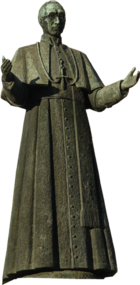
The last years of the pontificate of Pius XII began in late 1954 with a long illness, during which he considered resignation. Afterwards changes in his work habit became noticeable. The Pope avoided long ceremonies, canonizations and consistories and displayed hesitancy in personnel matters. During the last years of the pontificate, Pius XII procrastinated personnel decisions within his Vatican, and found it increasingly difficult to chastise subordinates and appointees such as Riccardo Galeazzi-Lisi, who, after numerous indiscretions was excluded from Papal service for the last years, but, keeping his title, was able to enter the papal apartments to make photos of the dying Pope, which he sold to French magazines.
Pius XII often elevated young priests as bishops, such as Julius Döpfner (35 years) and Karol Wojtyla (38 years), one of his last appointees in 1958. He took a firm stand against pastoral experiments, such as " worker-priests", who worked full times in factories and joined political parties and unions. He continued to defend the theological tradition of Thomism as worthy of continued reform, and as superior to modern trends such as phenomenology or existentialism.
Illness and death of Pope Pius XII
Since his 1954 illness, Pope Pius addressed lay people and groups with in an unprecedented range of topics. Frequently, he spoke to members of scientific congresses, explaining Christian teachings in light of most recent scientific results. Sometimes he answered specific moral questions, which were addressed to him. To professional associations he explained specific occupational ethics in light of Church teachings.
Before 1955, Pacelli worked for many years with Giovanni Battista Montini. The Pope did not have a full time assistant. Robert Leiber, helped him occasionally with his speeches and publications. Augustin Bea, was his personal confessor. Madre Pascalina Lehnert was for forty years his housekeeper and assistant. Domenico Tardini was probably closest to him
Pius XII died on October 9, 1958 in Castel Gandolfo, the Papal Summer Residence. His funeral procession into Rome was the largest congregation of Romans as of that date, Romans mourned "their" Pope, who was born in their city, especially as hero in time of war. The Testament of Pope Pius XII was published immediately after his death. Pope Pius XII's cause of canonization was opened on November 18, 1965 by Pope Paul VI. On September 2, 2000, during the pontificate of Pope John Paul II, Pius XII was given the title of Venerable.
Views, interpretations, and scholarship
Contemporary
During the war, the pope was widely praised. For example, Time Magazine credited Pius XII and the Catholic Church for "fighting totalitarianism more knowingly, devoutly, and authoritatively, and for a longer time, than any other organized power". During the war he was also praised editorially by the New York Times for opposing Nazi anti-semitism and aggression. Some early works echoed these favorable sentiments, including Polish historian Oskar Halecki's Pius XII: Eugenio Pacelli: Pope of peace (1954) and Nazareno Padellaro's Portrait of Pius XII (1949).
Many Jews publicly thanked the pope for his help. For example, Pinchas Lapide, a Jewish theologian and Israeli diplomat to Milan in the 1960s, estimated that Pius "was instrumental in saving at least 700,000 but probably as many as 860,000 Jews from certain death at Nazi hands." Some historians have questioned this oft-cited number, which Lapide reached by "deducting all reasonable claims of rescue" by non-Catholics from the total number of European Jews surviving the Holocaust. Catholic scholar Kevin Madigan interprets this and other praise from prominent Jewish leaders, including Golda Meir, as less than sincere, an attempt to secure Vatican recognition of the State of Israel.
Pius was also criticized during his lifetime. For example, Leon Poliakov wrote five years after World War II that Pius had been a tacit supporter of Vichy France's anti-Semitic laws, calling him "less forthright" than Pope Pius XI either out of "Germanophilia" or the hope that Hitler would defeat communist Russia. Bishop Carlos Duarte Costa, a long-time critic of Pius XII's policies during the war and an opponent of clerical celibacy and the Tridentine Mass, was excommunicated by Pius XII on July 2, 1945.
On September 21, 1945, the general secretary of the World Jewish Council, Dr. Leon Kubowitzky, presented an amount of money to the pope, "in recognition of the work of the Holy See in rescuing Jews from Fascist and Nazi persecutions."
After the war, in the autumn of 1945, Harry Greenstein from Baltimore, a close friend of Chief Rabbi Herzog of Jerusalem, told Pius how grateful Jews were for all he had done for them. "My only regret," the pope replied, "is not to have been able to save a greater number of Jews."
The Deputy
In 1963, Rolf Hochhuth's controversial drama Der Stellvertreter. Ein christliches Trauerspiel (The Deputy, a Christian tragedy, released in English in 1964) portrayed Pope Pius XII as a hypocrite who remained silent about the Holocaust. Books such as Dr. Joseph Lichten's A Question of Judgment (1963), written in response to The Deputy, defended Pius XII's actions during the war. Lichten labelled any criticism of the pope's actions during World War II as "a stupefying paradox" and said, "no one who reads the record of Pius XII's actions on behalf of Jews can subscribe to Hochhuth's accusation." Critical scholarly works like Guenter Lewy's The Catholic Church and Nazi Germany (1964) also followed the publication of The Deputy. In 2002 the play was adapted into the film Amen.
Actes
In the aftermath of the controversy surrounding The Deputy, in 1964 Pope Paul VI authorized Jesuit scholars to access the Vatican State Department Archives , which are normally not opened for seventy-five years. Actes et Documents du Saint Siège relatifs à la Seconde Guerre Mondiale, was published in eleven volumes between 1965 and 1981.The volumes were published by Angelo Martini, Burkhart Schneider, Robert Graham and Pierre Blet, the latter published a summary of the eleven volumes All four, most frequently Robert Graham published articles and books on the subject matter.
Hitler's Pope
In 1999, John Cornwell's Hitler's Pope criticized Pius for not doing enough, or speaking out enough, against the Holocaust. Cornwell argued that Pius's entire career as the nuncio to Germany, cardinal secretary of state, and pope was characterized by a desire to increase and centralize the power of the Papacy, and that he subordinated opposition to the Nazis to that goal. He further argues that Pius was anti-Semitic and that this stance prevented him from caring about the European Jews.
Cornwell's work was the first to have access to testimonies from Pius's beatification process as well as to many documents from Pacelli's nunciature which had just been opened under the seventy-five year rule by the Vatican State Secretary archives. Cornwell concluded, "Pacelli's failure to respond to the enormity of the Holocaust was more than a personal failure, it was a failure of the papal office itself and the prevailing culture of Catholicism."
Cornwell's work has received much praise and criticism. Much praise of Cornwell centered around his statement that he was a practising Catholic who had attempted to absolve Pius with his work. Works such as Susan Zuccotti's Under His Very Windows: The Vatican and the Holocaust in Italy (2000) and Michael Phayer's The Catholic Church and the Holocaust, 1930–1965 (2000) are critical of both Cornwell and Pius XII.
Cornwell's scholarship has been criticized. For example, Kenneth L. Woodward stated in his review in Newsweek that "errors of fact and ignorance of context appear on almost every page." Cornwell himself gives a more ambiguous assessment of Pius' conduct in a 2004 interview where he states that "Pius XII had so little scope of action that it is impossible to judge the motives for his silence during the war". Most recently, Rabbi David Dalin's The Myth of Hitler's Pope argues that critics of Pius are liberal Catholics and ex-Catholics who "exploit the tragedy of the Jewish people during the Holocaust to foster their own political agenda of forcing changes on the Catholic Church today" and that Pius XII was actually responsible for saving the lives of many thousands of Jews..
ICJHC
In 1999, in an attempt to address some of this controversy, the Vatican appointed the International Catholic-Jewish Historical Commission (ICJHC), a group composed of three Jewish and three Catholic scholars to investigate the role of the Church during the Holocaust. In 2001, the ICJHC issued its preliminary finding, raising a number of questions about the way the Vatican dealt with the Holocaust, titled " The Vatican and the Holocaust: A Preliminary Report."
The Commission discovered documents making it clear that Pius was aware of widespread anti-Jewish persecution in 1941 and 1942, and they suspected that the Church may have been influenced in not helping Jewish immigration by the nuncio of Chile and the Papal representative to Bolivia, who complained about the "invasion of the Jews" to their countries, where they engaged in "dishonest dealings, violence, immorality, and even disrespect for religion."
The ICJHC raised a list of 47 questions about the way the Church dealt with the Holocaust, requested documents that had not been publicly released in order to continue their work, and, not receiving permission, they disbanded in July of 2001, having never issued a final report. Unsatisfied with the findings, Dr. Michael Marrus, one of the three Jewish members of the Commission, said the commission "ran up against a brick wall.... It would have been really helpful to have had support from the Holy See on this issue."
